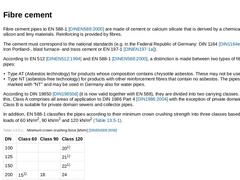
|
Fibre cement pipes to EN 588-1 [DINEN588:2000] are made of cement or calcium silicate that is derived by a chemical reaction of silicon and limy materials. Reinforcing is provided by fibres. The cement must correspond to the national standards (e.g. in the Federal Republic of Germany: DIN 1164 [DIN1164e] Portland-, Iron Portland-, blast furnace- and trass cement or EN 197-1 [DINEN197-1a]). According to EN 512 [DINEN512:1994] and EN 588-1 [DINEN588:… |
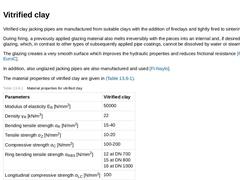
|
Vitrified clay jacking pipes are manufactured from suitable clays with the addition of fireclays and tightly fired to sintering at 1210°C. During firing, a previously applied glazing material also melts irreversibly with the pieces into an internal and, if desired, external glazing, which, in contrast to other types of subsequently applied pipe coatings, cannot be dissolved by water or steam pressure. The glazing creates a very smooth surface which … |
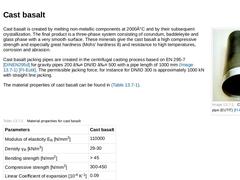
|
(Image: Cast basalt jacking pipe (EUTIT) [FI-Eutit]) Cast basalt is created by melting non-metallic components at 2000°C and by their subsequent crystallization. The final product is a three-phase system consisting of corundum, baddeleyite and glass phase with a very smooth surface. These minerals give the cast basalt a high compressive strength and especially great hardness (Mohs' hardness 8) and resistance to high temperatures, corrosion and abrasion. |
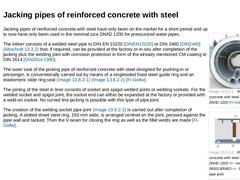
|
|
(Image: Reinforced concrete with steel jacking pipe DN/ID 1200 [FI-Gollw] - View)
|
|
(Image: Reinforced concrete with steel jacking pipe DN/ID 1200 - Design of the pipe joint)
|
Jacking pipes of reinforced concrete with steel have only been on the market for a short period and up to now have only been used in the nominal size DN/ID 1200 for pressurized water pipes. The inliner consists of a welded steel pipe to DIN EN 10220 [DINEN10220] or DIN 2460 [… |
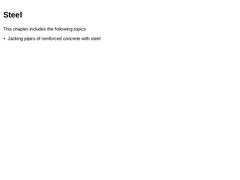
|
|
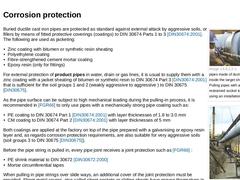
|
|
(Image: Installation of pipes made of ductile cast iron inside the target shaft [Fitzt00] - Pulling pipes with a tensile restrained socket together by using an installation device)
|
|
(Image: Installation of pipes made of ductile cast iron inside the target shaft [Fitzt00] - Lifting an 18m ductile cast iron pipe string, consisting of three discrete pipes, onto a pulling-in slide with an inclination of 6°)
|
Buried ductile cast iron pipes are protected … |
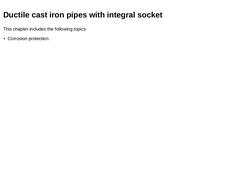
|
|
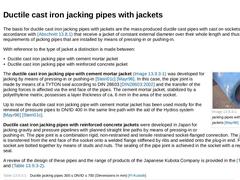
|
The basis for ductile cast iron jacking pipes with jackets are the mass-produced ductile cast pipes with cast on sockets in accordance with Abschnitt 13.8.1 that receive a jacket of constant external diameter over their whole length and thus also fulfil the requirements of jacking pipes that are installed by means of pressing-in or pushing-in. With reference to the type of jacket a distinction is made between: - Ductile cast iron jacking pipe with cement …
|
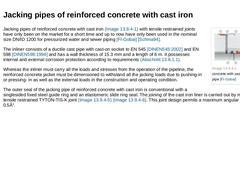
|
(Image: Reinforced concrete with cast iron jacking pipe [FI-Gobai]) Jacking pipes of reinforced concrete with cast iron (Bild 13.8.3) with tensile restrained joints have only been on the market for a short time and up to now have only been used in the nominal size DN/ID 1200 for pressurized water and sewer piping [FI-Gobai] [Schma94]. The inliner consists of a ductile cast pipe with cast-on socket to EN 545 [DINEN545:2002] and EN 598 [DINEN598:1994] … |
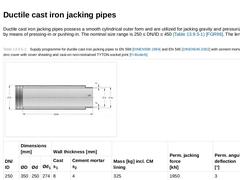
|
Ductile cast iron jacking pipes possess a smooth cylindrical outer form and are utilized for jacking gravity and pressurized pipelines by means of pressing-in or pushing-in. The nominal size range is 250 ≤ DN/ID ≤ 450 (Tabelle 13.8.4) [FGR96]. The length is 2 m. (Table: Supply programme for ductile cast iron jacking pipes to EN 598 [DINEN598] and EN 545 [DINEN545a] with cement mortar lining, external zinc cover with cover sheating and cast-on non-… |
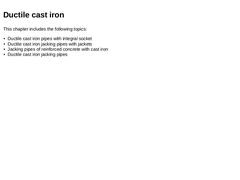
|
|
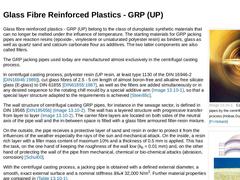
|
|
(Image: Casting of GRP pipes by the centrifugal spray process (Hobas Durotec GmbH) [FI-Hobasb])
|
|
(Image: Wall structure of a GRP jacking pipe cast by the centrifugal spray process (Hobas Durotec GmbH) [FI-Hobasb])
|
Glass fibre reinforced plastics - GRP (UP) belong to the class of duroplastic synthetic materials that can no longer be melted under the influence of temperature. The starting materials for GRP jacking pipes are reaction resins (epoxide-, … |
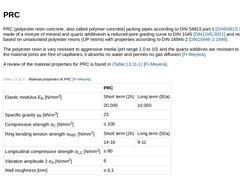
|
PRC (polyester resin concrete, also called polymer concrete) jacking pipes according to DIN 54815 part 1 [DIN54815:1998] are made of a mixture of mineral and quartz additivesin a reduced-pore grading curve to DIN 1045 [DIN1045:2001] and reaction resin based on unsaturated polyester resins (UP resins) with properties according to DIN 16946-2 [DIN16946-2:1989]. The polyester resin is very resistant to aggressive media (pH range 1.0 to 10) and the quartz … |
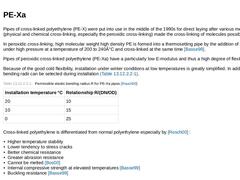
|
Pipes of cross-linked polyethylene (PE-X) were put into use in the middle of the 1990s for direct laying after various methods (physical and chemical cross-linking, especially the peroxidic cross-linking) made the cross-linking of molecules possible. In peroxidic cross-linking, high molecular weight high density PE is formed into a thermosetting pipe by the addition of peroxide under high pressure at a temperature of 200 to 240°C and cross-linked … |
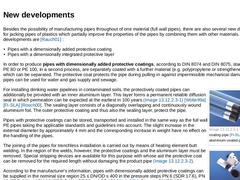
|
Besides the possibility of manufacturing pipes throughout of one material (full wall pipes), there are also several new developments for jacking pipes of plastics which partially improve the properties of the pipes by combining them with other materials. Among these developments are [Rauch01] : - Pipes with a dimensionally added protective coating
- Pipes with a dimensionally integrated protective layer
In order to produce pipes with dimensionally added … |
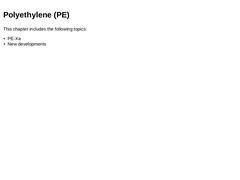
|
|
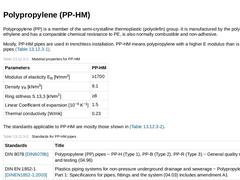
|
Polypropylene (PP) is a member of the semi-crystalline thermoplastic (polyolefin) group. It is manufactured by the polymerization of ethylene and has a comparable chemical resistance to PE, is also normally combustible and non-adhesive. Mostly, PP-HM pipes are used in trenchless installation. PP-HM means polypropylene with a higher E modulus than is usual with PP pipes (Tabelle 13.11.2). (Table: Material properties for PP-HM) The standards applicable … |
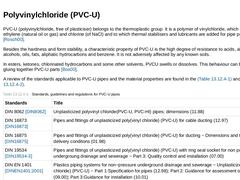
|
PVC-U (polyvinylchloride, free of plasticiser) belongs to the thermoplastic group. It is a polymer of vinylchloride, which is made of ethylene (natural oil or gas) and chlorine (of NaCl) and to which thermal stabilisers and lubricants are added for pipe production [Rosch00]. Besides the hardness and form stability, a characteristic property of PVC-U is the high degree of resistance to acids, alkalis, alcohols, oils, fats, aliphatic hydrocarbons and … |
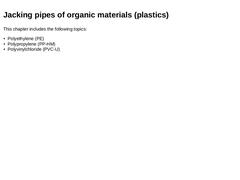
|
|
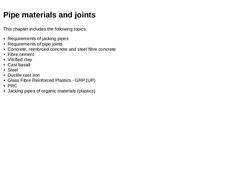
|
|
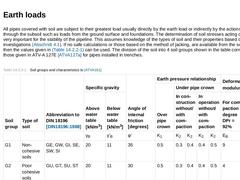
|
All pipes covered with soil are subject to their greatest load usually directly by the earth load or indirectly by the actions transferred through the subsoil such as loads from the ground surface and foundations. The determination of soil stresses acting on the pipe is very important for the stability of the pipeline. This assumes knowledge of the types of soil and their properties based on soil investigations (Abschnitt 4.1). If no safe calculations … |
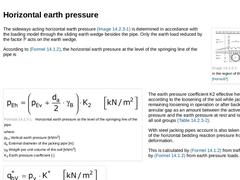
|
(Image: Earth load stress in the region of the jacking pipe [Hornu87]) The sideways acting horizontal earth pressure (Bild 14.1.2) is determined in accordance with the loading model through the sliding earth wedge besides the pipe. Only the earth load reduced by the factor κ acts on the earth wedge. According to Formel 14.1.2, the horizontal earth pressure at the level of the springing line of the pipe is (Formula: Horizontal earth pressure at the … |
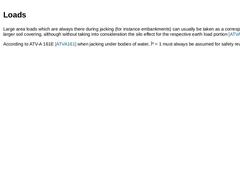
|
Large area loads which are always there during jacking (for instance embankments) can usually be taken as a correspondingly larger soil covering, although without taking into consideration the silo effect for the respective earth load portion [ATVA161]. According to ATV-A 161E [ATVA161] when jacking under bodies of water, κ = 1 must always be assumed for safety reasons. |
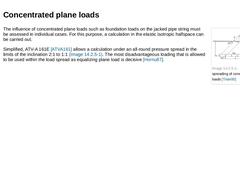
|
(Image: Pressure spreading of concentrated plane loads [Trian00]) The influence of concentrated plane loads such as foundation loads on the jacked pipe string must be assessed in individual cases. For this purpose, a calculation in the elastic isotropic halfspace can be carried out. Simplified, ATV-A 161E [ATVA161] allows a calculation under an all-round pressure spread in the limits of the inclination 2:1 to 1:1 (Bild 14.1.4). The most disadvantageous … |
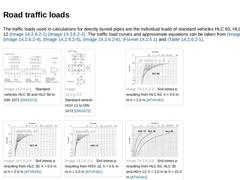
|
The traffic loads used in calculations for directly buried pipes are the individual loads of standard vehicles HLC 60, HLC 30 and HGV 12 (Bild 14.1.5.1) (Bild 14.1.5.1). The traffic load curves and approximate equations can be taken from Bild 14.1.5.1, Bild 14.1.5.1, Bild 14.1.5.1, Bild 14.1.5.1, Formel 14.1.5.1 and Tabelle 14.1.5.1. | (Image: Standard vehicles HLC 30 and HLC 60 to DIN 1072 [DIN1072]) |
(Image: Standard vehicle HGV 12 to DIN 1072 [DIN1072]) |
|